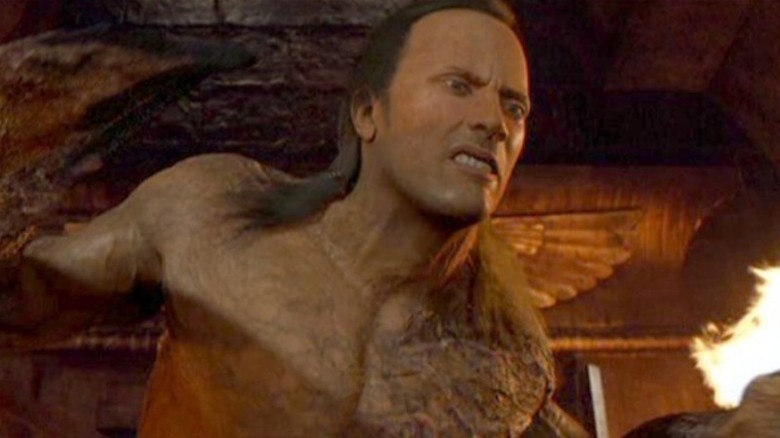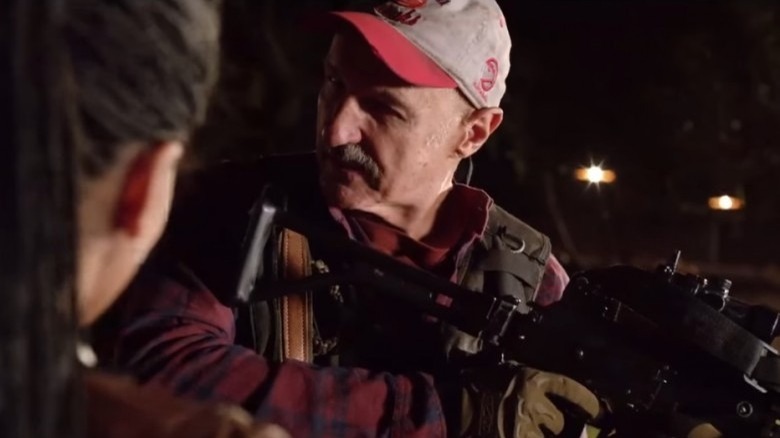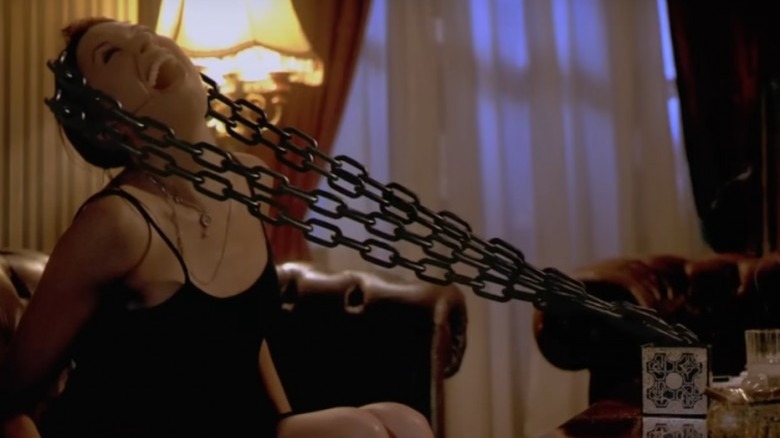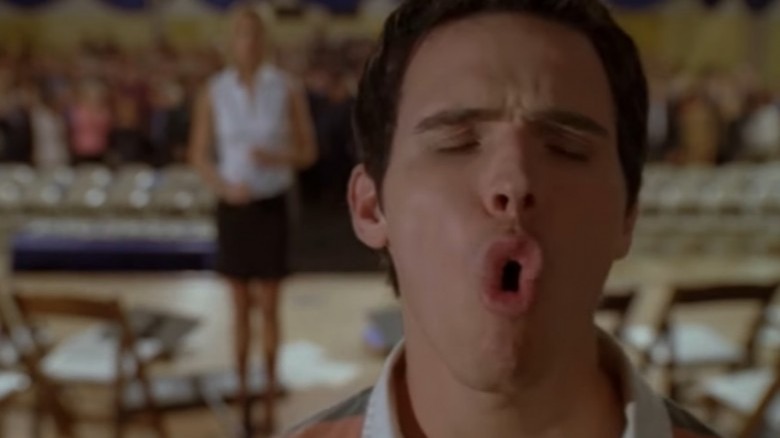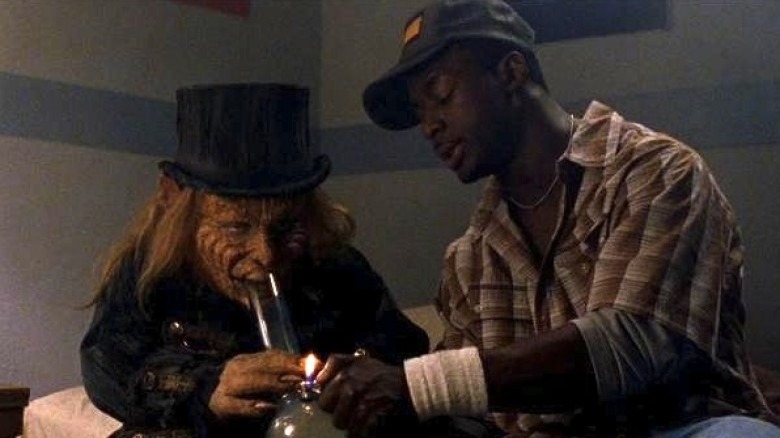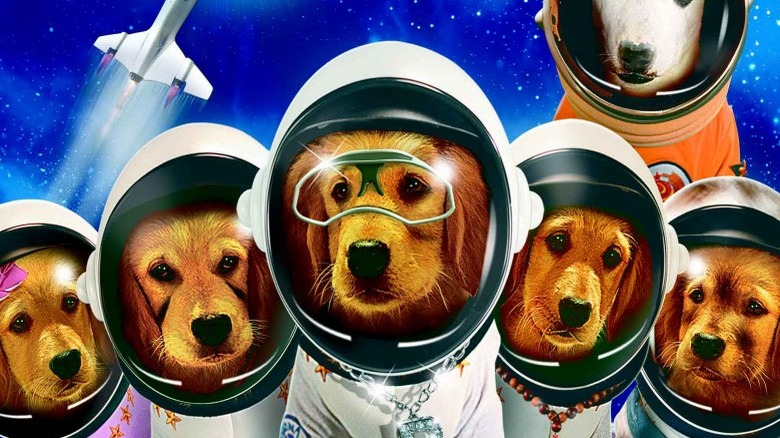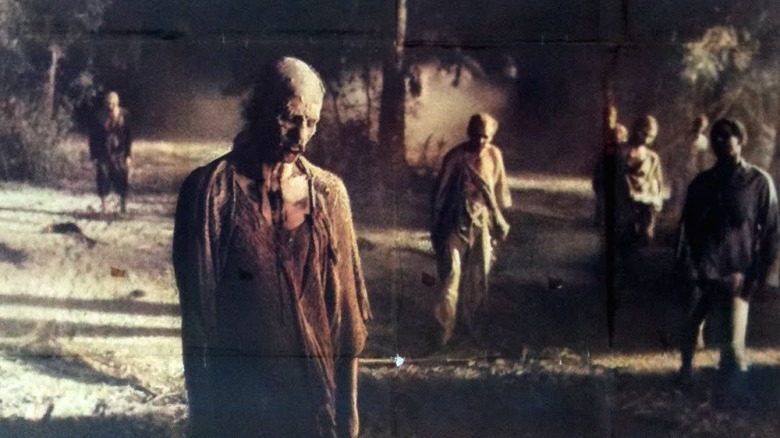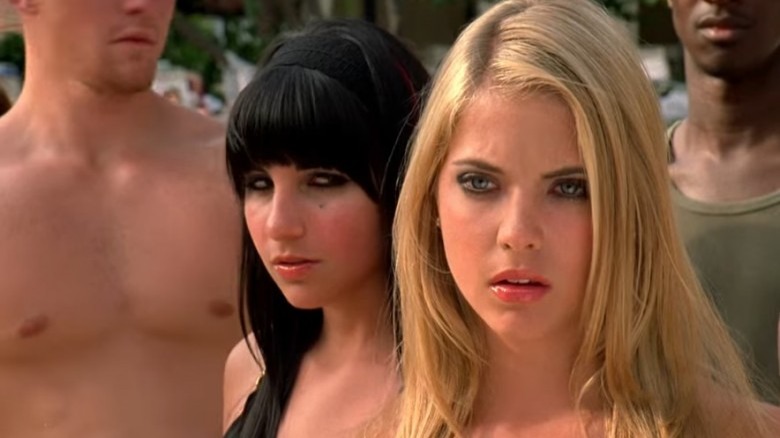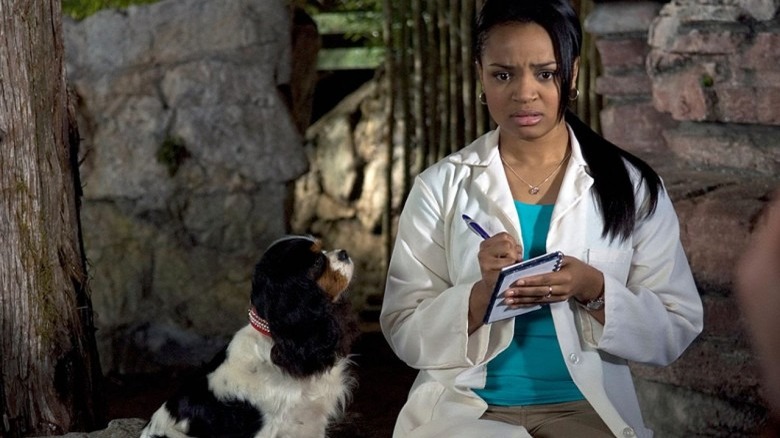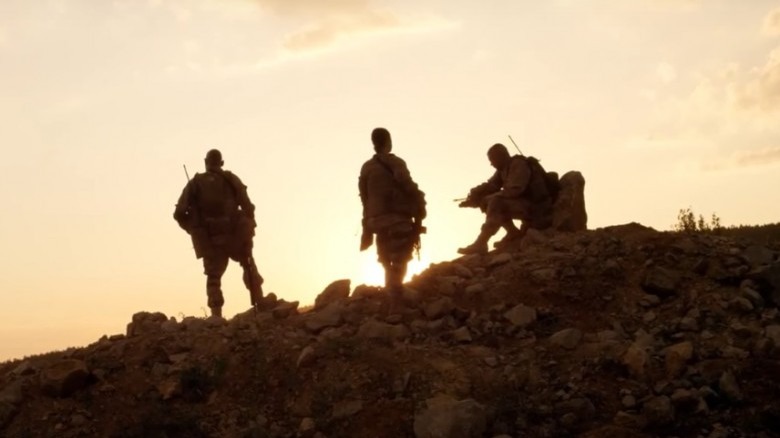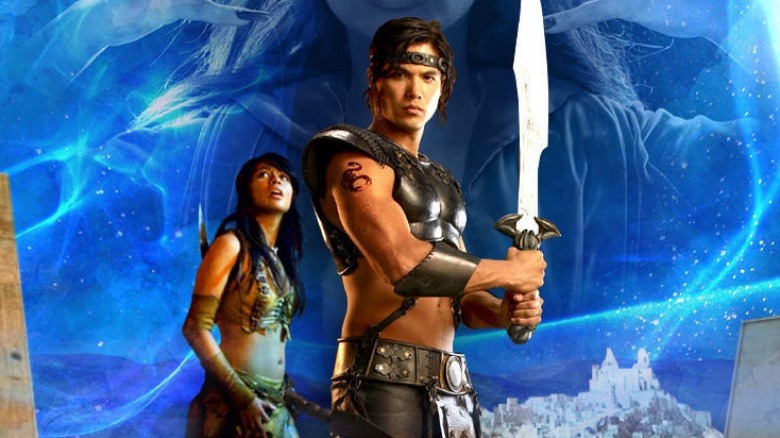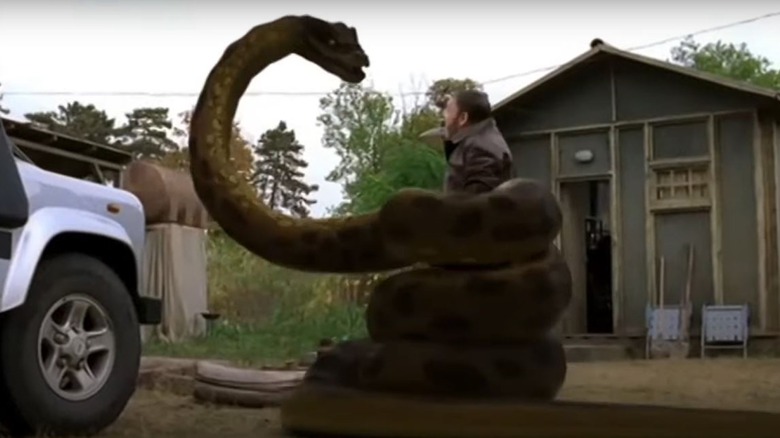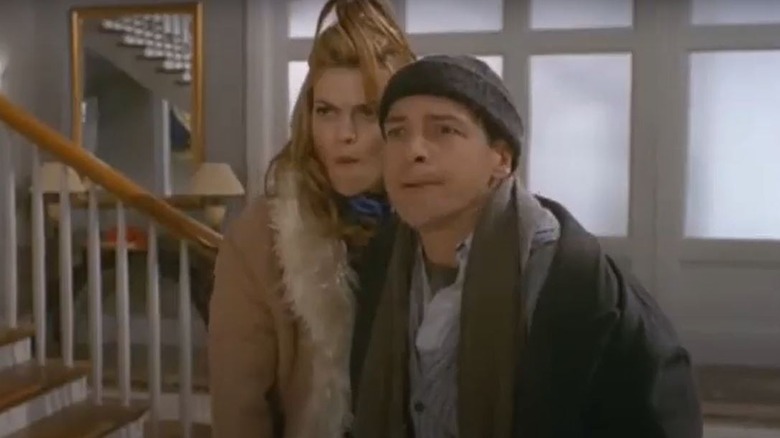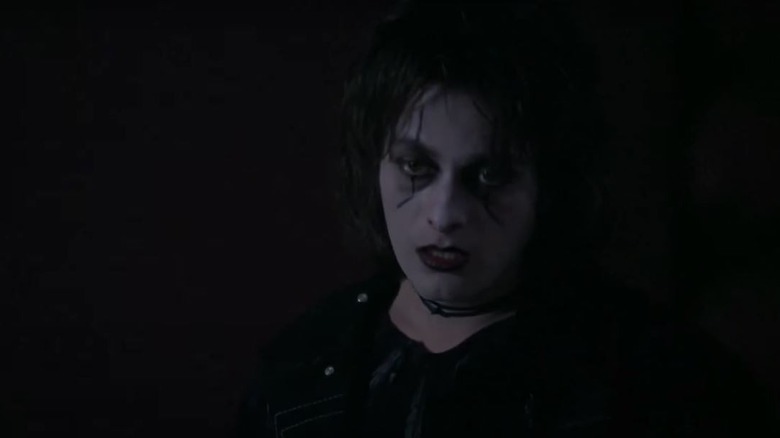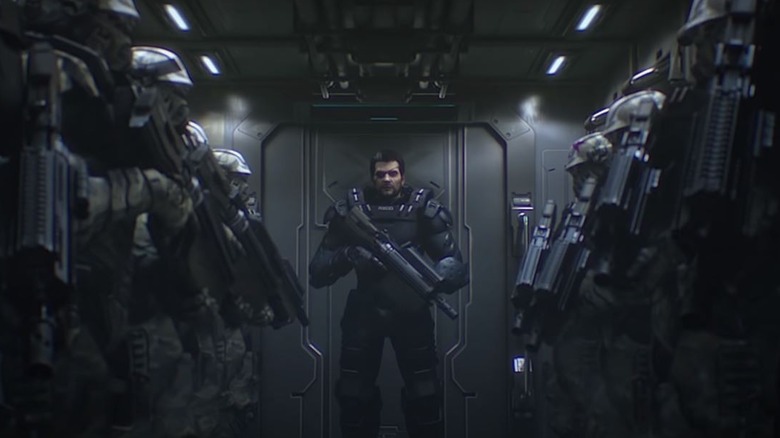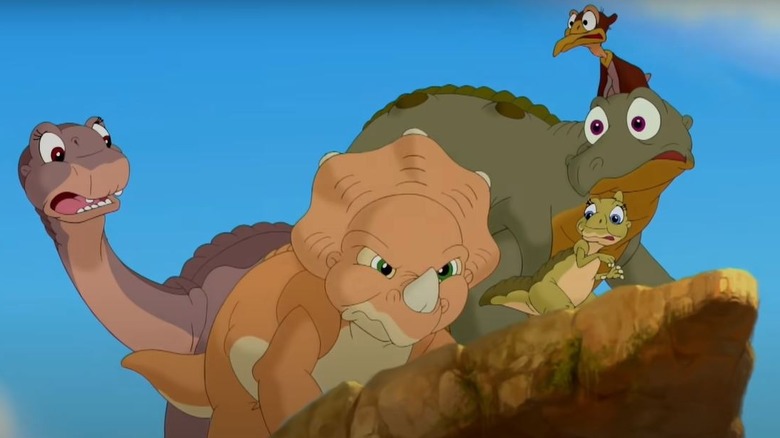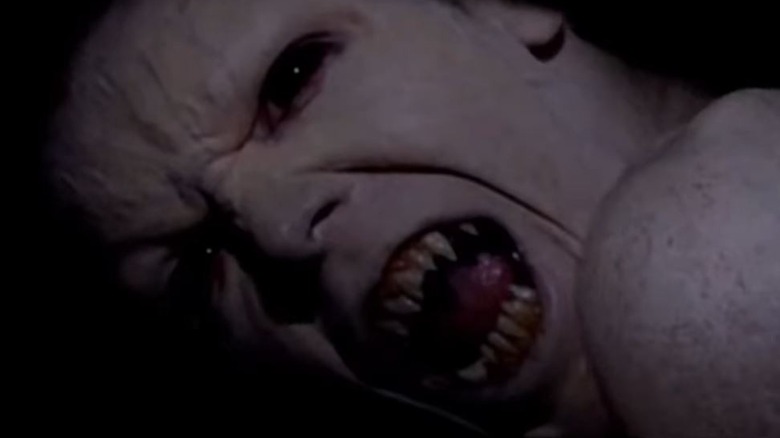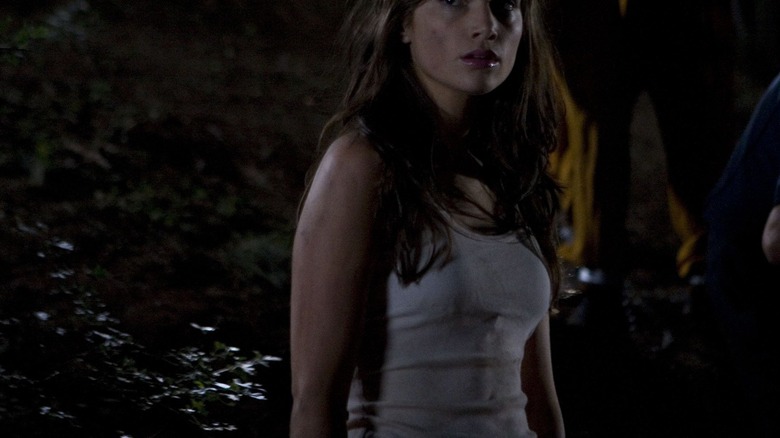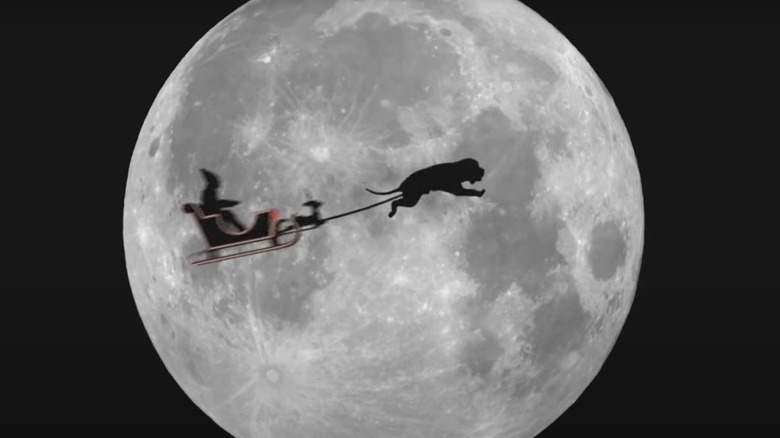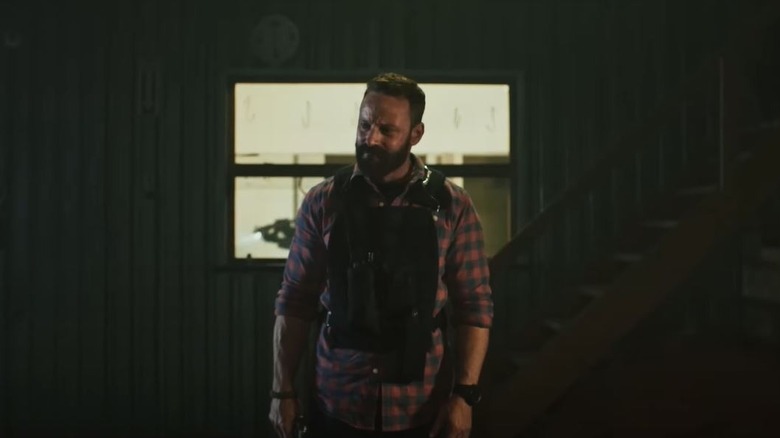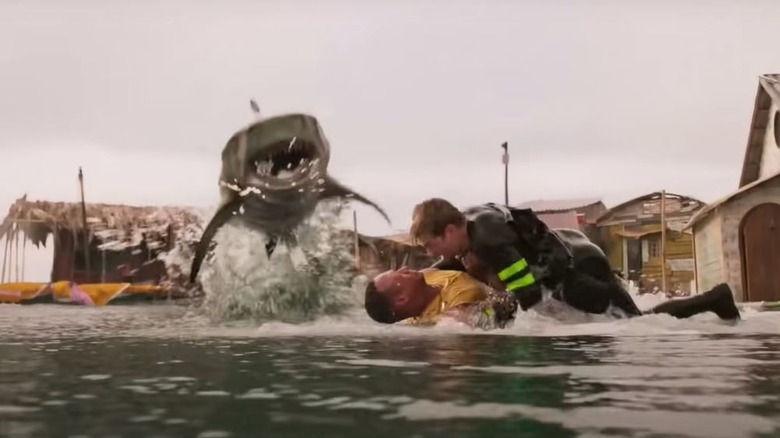Movie Series You Didn't Know Kept Releasing Low-Budget Sequels
In today's franchise-hungry Hollywood, every successful movie has a sequel waiting to happen. But not all franchises are created equal: sometimes, studios just can't leave well enough alone, and they'll flog a film series for every last dollar it can produce in the lower-budget direct-to-video (or DTV) market. Sometimes actors from the first films stick around for the entire ride, though they're rarely the original leads—you're not seeing, say, Kevin Bacon popping up in Tremors 4. What you might see, on the other hand, are some surprising gems—among many, many more unbearable cash grabs. Let's run down some of the stranger series that have been out there under your nose, churning out sequels that you've never seen.
Tremors
Released in 1990, Tremors is a classic creature feature of the sort you tend to find flipping channels across basic cable. Starring Kevin Bacon and Fred Ward as a couple of handymen in the down-and-out town of Perfection, Nevada, it's an engaging and charming us vs. them buddy comedy, where the "them" is a race of subterranean worm monsters that respond to vibrations in the ground and swallow people whole. With such a fun premise—it's basically "The Floor is Lava: the Movie"—it's no wonder it spawned a whole direct-to-video series, and even a short-lived television show.
Though actor Ward returned 1996's not-bad Tremors 2: Aftershocks, succeeding entries saw diminishing returns, from the introduction of flying raptor variations on the series' "Ass Blasters" monsters in Tremors 3: Back to Perfection, to a forgettable western prequel set in 1889. In 2015, a fifth sequel was released co-starring Jamie Kennedy, which isn't all that terrible. And though the quality of the films may be uneven, you have to admire that through all these installments, including the TV show, actor Michael Gross has shown up to clock in as absurdly well-prepared survivalist Burt Gummer. He's so clearly having fun with it that it's infectious. In short, producers, please do not remake these movies! If Michael Gross is still on board, just bring on Tremors 6.
Hellraiser
A divisive crucible of horror, Clive Barker's directorial debut Hellraiser has been called both "incredible, and incredibly disturbing" and a half-star earning "bankruptcy of imagination." Is it possible for both to be true? Regardless of the movie's quality (it's mostly fine), it's undeniably visually striking, debuting Pinhead and the Cenobites against a gnarly tableau of industrial hell. But if there's any debate about the quality of the original, there's little-to-none about the following eight (soon to be nine) sequels. They're awful in many ways. Want an anthology film that was edited into an incoherent mess? Try the fourth one, Hellraiser: Bloodline. An unrelated script that was grafted onto the series with little relation to what came before? Try Hellraiser: Deader. (Yes, "Deader.") The series didn't go direct-to-DVD and truly off the rails until the fifth installment, 2002's Hellraiser: Hellseeker, yet the sequels continue, with Hellraiser: Judgment set for release this year.
American Pie
For one reason or another, the American Pie franchise has taken a Marvel Studios sort of approach to their sprawling media machine, with a cinematic universe comprised of American Pie 1 & 2, American Wedding, and American Reunion, all of which you might have seen or heard of. But they've also got a television universe with lower budgets and lower star wattage that gets a lot less love. The DTV entries—Band Camp, The Naked Mile, Beta House, and The Book of Love—are side stories loosely tied to the mothership by having the main characters be brothers or cousins of Stifler. The Nick Fury figure tying the whole universe together? That would be Eugene Levy, who has appeared in every installment, as can be confirmed by a look at one of our all-time favorite Wikipedia charts.
Leprechaun
All you really need to know about the original Leprechaun, released in 1993, is that a pre-Friends Jennifer Aniston is in it (a fact the marketing people got a lot of mileage out of on the film's eventual DVD release.) These movies have always been schlock amongst schlock, puzzling at best—have we ever found leprechauns to be scary?—but they at least deserve credit for hitting every single horror movie trope setting along the way. The Leprechaun goes to Vegas. The Leprechaun goes to space. The Leprechaun went to "the hood," and actually, it was pretty good. (The Leprechaun then went "back 2 tha hood," and it was not.) A seventh installment, the only one yet to arrive without original star Warwick Davis, crawled out of the DTV gutter for a brief theatrical release and universal critical rejection in 2014. But bad reviews have never stopped this inexplicable series before; with a track record of such bad reviews, it's basically right on track.
Air Bud
Oh boy. Air Bud, Air Bud, what did you do? From an inauspicious start in 1997 as a feel-good family movie about a dog that plays basketball and the boy who befriends him (versus a truly discomfiting, uh, alcoholic clown), Air Bud's journey into money-printing franchise history proceeded slowly at first. First there was the traditional sequel, released in theaters, in which the dog plays football. In the new millennium, he learned how to play soccer, baseball, and finally volleyball, which, okay. This could have easily gone on forever, until someone had the brilliant idea to leave the sports behind, as well as anything resembling reality, with the release in 2006 of Air Buddies, where there were lots of dogs. Talking dogs.
At this point, all bets were off, and over the next seven years, the buddies faced snow, space, did Halloween, made a lateral career move into archaeology, gained superpowers, and met Santa. Santa Buddies then split into its own universe, with a prequel called The Search for Santa Paws, and a sequel which features "a sad subplot about a widower and his two motherless kids who are having a hard time dealing with Christmas." Look, we saw Air Bud—we didn't watch any of these. We present them without comment; the Air Bud universe, more convoluted in its continuity than 83 years' worth of DC Comics, just makes us feel numb.
Universe of the Living Dead
The influence of George Romero's black-and-white 1968 Night of the Living Dead simply cannot be overstated. It spawned direct sequels and imitators, spinoff series and foreign adaptations, and that's just in its own franchise. As a larger piece of cultural art, it's gargantuan, informing almost every trope we still adhere to in the ever-vibrant zombie genre that continues with shows like The Walking Dead (and its own spinoff) up to this day.
As to the shape of the series? It's a mess, but this being the internet, it's a mess that people picked through until it made sense. John D'Amico with Smugfilm and Alex Carter with Den of Geek have both produced slightly-different, equally exhaustive flowcharts of the sequels, remakes, and re-edits that make up the Living Dead series all around the world. That's right, flowcharts: not lists. These are wheels within wheels we speak of now, ladies and gentlemen. Not these straight lines and trilogies you've grown accustomed to. Because this is zombies. baby! This is chaos. We don't need a logical throughline. We don't need a budget. And the best part is? Lots of these movies are actually pretty damn good.
Bring It On
Ask a friend, if they can remember it, how many sequels they think 2000's delightfully bitchy cheerleader showdown Bring it On produced, if they can remember the movie at all. One? We remembered one. Oh, how blind we were. First to video release was 2004's Bring it On Again, a copycat non-sequel that carried over none of the cast or crew from the original. After that, it starts to get really fun, with each succeeding entry featuring a new starlet on the rise in an unprestigious role. For Bring it On: All or Nothing there's Hayden Panettiere, for In It to Win It there's Ashley Benson, and for the most recent entry, Fight to the Finish, there's Christina Milian. And while there's no new installment on the horizon, this roughly 20-year-old picture seems ripe for some kind of a reboot... perhaps as a musical, with music and lyrics co-written by the more-popular-than-ever Lin-Manuel Miranda. Yes... perhaps indeed. (No joke, we would totally watch this.)
Dr. Dolittle
So, talking about this franchise thing. It's all marketing, right? It's all about name recognition, branding, business school 101. And Dr. Dolittle as a property is a pretty good example. It sprung from a series of children's books written beginning in the 1920s, all the way up to 1952. While many TV shows and radio plays were produced about the story, a simple thing about a human doctor who prefers to speak to animals, the franchise went modern when was adapted for a 1967 musical film, which was later remade in its most currently well-known iteration, Eddie Murphy's 1998 version. That one did well enough to produce a theatrical sequel, still with Eddie Murphy, in 2001. But after that, the wheels came off and the cart kept rolling, with original cast member Kyla Pratt continuing on as the titular Doctor in a third and fourth and... fifth DTV sequel in 2009. After eight years on the shelf, this franchise seems ready for an Ace Ventura, Jr. reimagining. Do it, you guys. Do it.
Jarhead
This one feels dirty. The original Jarhead, released during the interminable height of the Iraq War, was a gritty, realistic, personal movie about the private hells of armed conflict—not marked by big explosions and combat, but more about the existential angst and terror that comes during the moments in between, and all set in a surreal sandy landscape that would be beautiful if it didn't invite so much dread. Directed by Sam Mendes with legendarily talented cinematographer Roger Deakins, the movie is gorgeous, stark, and unlike any war film you've seen this side of Apocalypse Now. It's great.
So, the sequels, nine years later. From the director of Lake Placid: The Final Chapter and Taken: The Search for Sophie Parker (no relation to Liam Neeson's saga of Takens) comes Jarhead 2: Field of Fire, which goes balls to the wall in all the ways its candy-ass sequel couldn't even dream of. Check out this trailer, and join us in a hearty direct-to-video Semper Fi. HOO RAH. And then there's Jarhead 3: The Siege, which... okay, that one just sucked.
The Scorpion King
If the Brendan Fraser Mummy trilogy was like the hit TV comedy ensemble Friends, then the spinoff mythology series it gave birth to, The Scorpion King, is like the Joey of Egyptian-flavored early-2000s action-horror. Introduced in 2001's The Mummy Returns, the Scorpion King was a hulking silent heel played by Dwayne "The Rock" Johnson in the early stages of his acting career, back when people still weren't sure what he was capable of. Though the movie wasn't reviewed well, the Rock earned positive notices as a "Conan with charisma" figure, and has built a career in Hollywood off that underestimated reputation ever since. Surprisingly, the franchise he kicked off is still chugging along as well, with artwork that seems to get more busy, more golden, and more like a Mortal Kombat knockoff with every successive go.
What with franchise flagship The Mummy coming back in remake form this year, could we also see a reinvigoration of the Scorpion King franchise? And wouldn't it be just a little bit better for the world... if we didn't?
Anaconda
The original 1997 "Anaconda" film, about an over-sized snake terrorizing a documentary crew through the Amazon Rainforest, was a forgettable project released amidst a barrage of killer creature movies, including "Bats," "Deep Blue Sea," and "Lake Placid." Although boasting an all-star '90s cast that included Jennifer Lopez, Owen Wilson, Jon Voight, and Ice Cube, the film has been generally panned for its cookie-cutter characters delivered with half-hearted performances. Despite being nominated for six Razzie Awards, the movie did well at the box office against a moderate budget. Of course, Hollywood could not leave well enough alone with the snake movie that exceeded expectations, and didn't hesitate to bleed the creature feature dry.
"Anaconda" offers an unnecessary four sequels, with the second film in the franchise "Anaconda: The Hunt for the Blood Orchid" the only one released in theatres. "Anaconda 3 & 4" were filmed back-to-back for release on the Sci-Fi Channel in 2008 and 2009. Finally, the fifth installment, also a made-for-television production, involved a crossover with another ongoing creature series in "Lake Placid vs. Anaconda." As misleading as the title may be, the Amazonian snake does not fight a body of water, but rather the giant crocodiles from the competitive franchise. But "Anaconda" is still not done: There was a reboot of the original film announced by Sony Pictures in 2020.
Home Alone
The original "Home Alone" is a cherished Christmas film beloved by audiences. Everything about the first film fell perfectly into place, written and directed by cinema legends John Hughes and Chris Columbus, featuring both a young charismatic Macauley Culkin and an unforgettable score from composer John Williams. Somehow, these creators were even able to recreate the magic with the sequel "Home Alone 2: Lost in New York." Unfortunately, "Home Alone" was not a gift that kept on giving.
Many fans of the holiday classic may be unaware that the "Home Alone" franchise now extends across six movies — some more forgettable than others. 1997's "Home Alone 3" was fortunate enough to feature a script from John Hughes, but was otherwise a broad departure from the originals. Where the made-for-television "Home Alone 4" went wrong was in its decision to recast original characters like Kevin McCallister and the Sticky Bandits without anybody from the original films taking part in the production, and the fifth film was equally forgettable. When Disney got their hands on the franchise, more effort was put into the streaming sequel "Home Sweet Home Alone." Unfortunately, the critically-panned sixth installment ultimately destroyed the chances of the potential Ryan Reynolds-led, cannabis-infused "Home Alone" remake, "Stoned Alone."
The Crow
Long before superhero films were dominating theaters across the country, "The Crow" was one of the first successful projects based on a comic book not named "Superman." Unfortunately, the movie is entwined with the tragedy of losing star Brandon Lee, who was fatally wounded while filming. However, the feature received positive reviews and has become a classic for its dark visual tone and production design.
The story of a resurrected musician set on vengeance based on James O'Barr's original comic book spawned an entire franchise that includes three sequels and a short-lived television series. Unfortunately, each of the movies released set the franchise further back, culminating in the critically derided "The Crow: Wicked Prayer." To make matters worse, many fans still hope for "The Crow" to fly to its former heights. Musician Rob Zombie once intended to make his directorial debut with "The Crow: 2037," while rapper DMX also missed out on a potential "The Crow" project. Thankfully, there is still hope for the franchise, with a remake of the 1994 film starring Bill Skarsgård soon to be released.
Starship Troopers
Fans of the science fiction film "Starship Troopers" may be unaware of how old the franchise actually is. The source material for the man vs. alien epic was a 1959 novel written by Robert A. Heinlein, while the first adaptation of the story was a 1988 six-part anime. Meanwhile, the 1997 film has built a legacy of controversy, analysis, and debate. Regardless of it all, "Starship Troopers" has become an unstoppable franchise that extends to today, with a reboot rumored to still be in development.
There is a surprising amount of "Starship Troopers" content available, including video games, an animated series, and five feature-length films. The first two sequels, "Hero of the Federation" and "Marauder," were direct-to-video projects that didn't make much of an impression. However, the third installment managed surprisingly decent reviews, thanks to the return of Casper Van Dien as John Rico. Two additional animated films, "Invasion" and "Traitor of Mars," are must-watches for only the most die-hard of fans. Meanwhile, a still-live website for the franchise indicates that there is more on the horizon for the "Starship Troopers" collection.
The Land Before Time
Ground-breaking for its time, the original "The Land Before Time," released in 1988, was an animated film with Hollywood power behind it. Directed by "The Secret of NIMH" legend Don Bluth, it also boasted Steven Spielberg and George Lucas as executive producers. A moderate success upon its release, the story about a group of displaced young dinosaurs grew to gigantic proportions, releasing new sequels far beyond what was necessary.
The first "Land Before Time" sequel surprisingly was not released until six years after the original, with neither Bluth, Spielberg, nor Lucas attached to the project. Regardless, the franchise began releasing a new movie almost annually until 2007. Adding to the content was a short-lived animated series that aired on Cartoon Network. "Land Before Time" simply could not be stopped, with "The Land Before Time XIV: Journey of the Brave" released in 2016. Although rumored to be the final film in the dino-sized collection, it is hard to believe that the "Land Before Time" franchise will carry on until they run out of Roman numerals for the titles.
The Amityville Horror
The story of what happened at 112 Ocean Avenue has become more than a legend: It's a paranormal dynasty that has outgrown its humble beginnings. The original story, as fictionalized in Jay Anson's 1977 novel "The Amityville Horror," involves a young family moving into a colonial home in Amityville, NY, who are quickly being forced to abandon it after being terrorized by paranormal activity. The original book received its own literary sequels, but nothing compares to the number of movies spun off from the haunted residential home.
The original "The Amityville Horror" movie was released in 1979, and since then, there has been a smorgasbord of remakes, sequels, and satires. There are so many "Amityville" features that it is nearly impossible to keep track, with IMDb, Wikipedia, and Rotten Tomatoes each offering different counts. However, there are at least 62 films attached to the legend, with a minimum of nine released in 2022 alone. Obviously, some are less faithful to the source material than others, such as "Amityville: Karen," about an entitled "Karen" who becomes possessed by the paranormal house, or the 2023 "Amityville Shark House." Regardless, it is safe to say that low-budget "Amityville" movies are, and may forever be, a consistent element of the B-grade horror subgenre.
Wrong Turn
The 2003 slasher film "Wrong Turn" was a horror movie nobody expected much from. Based on three cannibal brothers lurking in the forests of the Appalachian Mountains who capture and kill a group of young hikers, the movie did moderately well both critically and financially. Of course, any success for a horror movie instantly means a sequel in the modern age of cinema. However, the franchise that was spawned from the original film is nothing short of unexpected.
Currently, there are seven movies based on the grisly story, the most recent being the 2021 reboot originally titled "Wrong Turn: The Foundation." The latest installment reimagines most of the tale, with members of a centuries-old cult becoming the main antagonists. The other five sequels featured the same horrifying brothers — Three Finger, Saw Tooth, and One Eye — who terrorized Eliza Dushku in the original. Meanwhile, the original collection featured a degrading budget per movie, with "Wrong Turn 6: Last Resort" bankrolled with a meager $1 million budget.
Beethoven
Who doesn't love a story about a troublesome yet lovable Saint Bernard who wins over the hearts of its adoptive family while causing chaos around their home? What if they made that into eight movies? And what if the dog landed an acting job, uncovered lost treasure, and was voiced by Tom Arnold? The "Beethoven" franchise has certainly grown bigger than a cumbersome pet since its humble beginnings in the inaugural 1992 family comedy.
Originally written by celebrated filmmaker John Hughes — under a pseudonym because he didn't even want to be associated with the project — "Beethoven" was a charming film that managed to rake in the money. So, of course, Hollywood had to suck the beloved franchise bone dry. It could be argued that "Beethoven's 2nd" was a faithful and worthwhile sequel, but things definitely went downhill from there. The third installment featured a cross-country road trip, followed by a fourth movie involving a collection of new pet friends, and by the seventh film, Beethoven was being voiced by Tom Arnold and helping to fly Santa's sleigh. Much like the dog that dragged Charles Grodin across the first film, "Beethoven" is out of control.
Sniper
Here comes a franchise that no one was asking for, but it shot for the stars nonetheless. When the original "Sniper" was released in 1993, critics praised its fun approach to a classic psychological thriller. However, it was consistently noted as being unoriginal or shallow. And for the most part, it seemed like the creators behind "Sniper" took their moderate winnings and moved on. However, almost 10 years later, "Sniper" came back for a sequel that formed a B-grade franchise that simply won't stop.
There are now nine movies in the "Sniper" franchise, with a tenth reportedly on the way. Somehow, most of the low-budget films have managed to maintain many of the stars from the inaugural feature, including Billy Zane and Tom Berenger. But each of the subsequent direct-to-video sequels continues to be buried further toward the bottom of the bargain bin, with the latest installment, 2022's "Sniper: Rogue Mission" flying heavily under the radar of most media outlets. And whether anybody is watching or not, it seems as if "Sniper" has many more stories to come.
Deep Blue Sea
"Deepest. Bluest. My hat is like a shark's fin," are the unforgettable lyrics to LL Cool J's accompaniment song to his 1999 feature "Deep Blue Sea." If that doesn't scream "build a multi-film franchise" to you, then you just haven't been paying attention. "Deep Blue Sea" was another moderately successful '90s movie that is perhaps best remembered for the scene where Samuel L. Jackson is eaten by a gigantic shark. And for the longest time, the film remained a standalone embraced by action fans. However, Hollywood can't seem to leave well enough alone, and in 2018, they began building a franchise out of the shark movie. Because as we all know, shark tales are B-movie gold.
"Deep Blue Sea 2" and "Deep Blue Sea 3" are both direct-to-video films that carry on the story of the genetically modified sharks established in the first movie. Surprisingly, the sequels are adored by fans and critics alike. Specifically, the R-rated "Deep Blue Sea 3" has earned itself a respectably "fresh" Rotten Tomatoes score — although they did miss a real opportunity to call it "Deep Blue Three." Reports of a fourth film in the franchise have yet to be announced, but you know that somebody out there has to be planning a way to pick up this franchise for a collection of further features — especially if LL Cool J will sign on to reprise his role as Sherman "Preacher" Dudley.
